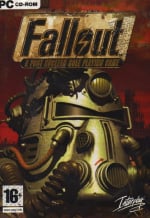Ever since setting up his YouTube channel "Cain on Games" back in April, the Fallout creator Tim Cain has been publishing daily videos about various topics related to his 40-year-plus career in the games industry. This inevitably includes a lot of never-before-heard stories about the making of Fallout, with the latest of these focusing on the discovery of a previously unknown design document that contains the original story treatment for the post-apocalyptic RPG (then called GURPS Survivors) and the first-ever mention of Vaults.
The video, uploaded on Friday, October 6th, sees Cain discuss how he came across the file titled "My Story" (which was written in January of 1995), before reading the treatment in full, and then outlining the pros and cons he had with it at the time.
The treatment starts with a detailed description of The Vault that seems very similar to what we ended up with. It reads:
"The Vault. A subterranean fallout shelter. A deep cavern expanded and modified to hold 1000 people for years after a Nuclear Holocaust. A small town of homes, businesses, and government offices all located hundreds of feet deep inside the heart of a granite mountain. Engineers and architects have planned for everything the inhabitants would need to continue their lives underground. Inexhaustible power came from a large geothermal heat exchanger sunk deep inside the mountain. A large cistern was filled with water and a recycling plant was built to keep it filled indefinitely. An atmospheric plant scrubbed the internal air and returned it refreshed to the caverns. Store rooms held crates of irradiated food packets for the survivors to consume after the world itself had become irradiated. And the door — a ponderous steel lock that protected The Vault was set into a reinforced concrete frame to keep the outside world away."
It then talks about the nuclear event itself and how when the bombs fell almost no one turned up, believing it to be another false alarm.
"On the day of the event, less than a hundred people made it inside The Vault. No one heeded the emergency broadcast, the police loudspeakers, the air sirens. These things had happened before all around the country and every time the outcome had been the same: a false alarm. A night spent in a cold, dank, shelter with hundreds of others waiting for the announcement that the emergency was over and that it was safe to leave. So most people stayed at home and most people died when the bombs fell.
"Nobody is really sure what happened. The event, as it came to be known, began and was over so quickly. A hostile nation had declared global war and the military was on full alert. The one hundred who came to The Vault sat in the entrance cavern just inside the door and waited for the announcement to return home. Then the door closed automatically. For several hours a great rhythmic pounding was heard. Those people that made it inside The Vault tried to find out what was happening outside but the radios and televisions inside produced only static and the radiation monitors mounted outside continued to show a rise on the internal monitors. Gradually the people realised that they were going to be inside The Vault for a long time."
According to this treatment, many people left The Vault before the player, taking the best weapons with them. Their objective was to scout out the environment and return, but nobody ever did. Then 80 years after the bomb dropped, food supplies started to get low (as opposed to the Water Chip breaking as in the finished game), leading The Vault's inhabitants to draw straws on who would go outside.
Cain listed four advantages to this proposal. For instance, he liked that the player and the character both knew nothing of the world outside and that it gave a logical reason for why the player is alone as going outside is considered a death sentence. He also felt it gave adequate time for places like Junktown (which had originally been designed) to exist and that it gave the player a purpose to chase after. As for the disadvantages, there were just two listed. These included the player having a set time limit to carry out their quest and being able to return to a home base for relative safety compared to the outside world.
As Cain notes, it's remarkable just how much of what became Fallout is present in this original treatment, especially as the game had yet to receive an official title.
If you enjoyed reading about this and want to hear more stories, we recommend subscribing to Cain on Games on YouTube and checking out Cain's incredible chat with Scott Campbell, one of the earliest members of the Fallout team.





